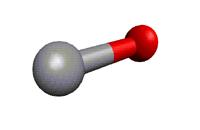Carbon Monoxide, v = 1 – 3
 | |
|---|---|
| Species tag | 028512 |
| Version | 1* |
| Date of Entry | May 2009 |
| Contributor | H. S. P. Müller |
|
The experimental transition frequencies were taken
from | |
| Lines Listed | 87 |
| Frequency / GHz | < 3500 |
| Max. J | 31 |
| log STR0 | -20.0 |
| log STR1 | -20.0 |
| Isotope Corr. | -0.0 |
| Egy / (cm–1) | 2143.27, 4260.06, 6350.44 |
| µa / D | 0.0850, 0.0597, 0.0348 |
| µb / D | |
| µc / D | |
| A / MHz | |
| B / MHz | 57111.24, 56586.56, 56061.9 |
| C / MHz | |
| Q(2000.) | 926.0021 (726.7430, 156.9540, 34.5521, 7.7529) |
| Q(1000.) | 380.2965 (362.6910, 16.7607, 0.8047, 0.0401) |
| Q(500.0) | 181.6871 (181.3025, 0.3836, 0.0009) |
| Q(300.0) | 108.8689 (108.8651, 0.0038) |
| Q(225.0) | 81.7185 (81.7184, 0.0001) |
| Q(150.0) | 54.5814 (54.5814) |
| Q(75.00) | 27.4545 (27.4545) |
| Q(37.50) | 13.8965 (13.8965) |
| Q(18.75) | 7.1223 (7.1223) |
| Q(9.375) | 3.7435 (3.7435) |
| detected in ISM/CSM | yes, v = 1 |